
Hi Everybody!!
Last post I told You I would bring You a bowl of bees tonight! I set up several other bee feeding stations in an effort to direct the million or so bees off the bird feeders. Your photostudy tonight is a tour of the progress. I will tell You these poor bees were starving upon arrival. They apparently told every other bee in Texas the location of Sugar Water Cafe (in my yard). Finally, today the bees slowed down and stopped swarming. They know they will get more food so they are not so frantic. Peace has been restored, but they are everywhere. People in the drought areas need to be aware the flowers are dead, there is no food for the bees. Please feed them some sugar water or hummingbird nectar on a shallow plate if you are on Migration route. Yes, they are still following me and dogs around on our walks! (They got Fat Sissy). Anyway, Enjoy and do not be scared of bees.
I set up this bowl with sugar water and a stick bridge. (Trying to get the bees off the bird feeders)
Let's Check Out some of the other bee feeding stations on a little walk:
Not as many bees on bird feeders! (Good)
This is the tray on the front deck:
https://en.wikipedia.org/wiki/Honey
Honey
From Wikipedia, the free encyclopedia
Honey /ˈhʌni/ is a sweet food made by bees using nectar from flowers. The variety produced by honey bees (the genus Apis) is the one most commonly referred to, as it is the type of honey collected by beekeepers and consumed by humans. Honey produced by other bees and insects has distinctly different properties.
Honey bees transform nectar into honey by a process of regurgitation and evaporation. They store it as a primary food source in wax honeycombs inside thebeehive.
Honey gets its sweetness from the monosaccharides fructose and glucose, and has approximately the same relative sweetness as that of granulated sugar.[1][2] It has attractive chemical properties for baking and a distinctive flavor that leads some people to prefer it over sugar and other sweeteners.[1] Most microorganismsdo not grow in honey because of its low water activity of 0.6.[3] However, honey sometimes contains dormant endospores of the bacterium Clostridium botulinum, which can be dangerous to infants, as the endospores can transform into toxin-producing bacteria in infants' immature intestinal tracts, leading to illness and even death.[4]
Honey has a long history in human consumption, and is used in various foods and beverages as a sweetener and flavoring. It also has a role in religion and symbolism. Flavors of honey vary based on the nectar source, and various types and grades of honey are available. It is also used in various medicinal traditions to treat ailments. The study of pollens and spores in raw honey (melissopalynology) can determine floral sources of honey.[5] Bees carry an electrostatic chargewhereby they attract other particles in addition to pollen, which become incorporated into their honey; the honey can be analysed by the techniques ofmelissopalynology in area environmental studies of radioactive particles, dust and particulate pollution.[6][7]
A jar of honey with honey dipper
Formation
Honey's natural sugars are dehydrated, which prevents fermentation, with added enzymes to modify and transform their chemical composition and pH. Invertases and digestive acids hydrolyze sucrose to give the monosaccharides glucose and fructose. The invertase is one of these enzymes synthesized by the body of the insect.
Honey bees transform saccharides into honey by a process of regurgitation, a number of times, until it is partially digested. The bees do the regurgitation and digestion as a group. After the last regurgitation, the aqueous solution is still high in water, so the process continues by evaporation of much of the water and enzymatic transformation.
Honey is produced by bees as a food source. In cold weather or when fresh food sources are scarce, bees use their stored honey as their source of energy.[8] By contriving for bee swarms to nest in artificial hives, people have been able tosemidomesticate the insects, and harvest excess honey. In the hive (or in a wild nest), there are three types of bees:
- a single female queen bee
- a seasonally variable number of male drone bees to fertilize new queens
- some 20,000 to 40,000 female worker bees.[9]
The worker bees raise larvae and collect the nectar that will become honey in the hive. Leaving the hive, they collect sugar-rich flower nectar and return.
In the hive, the bees use their "honey stomachs" to ingest and regurgitate the nectar a number of times until it is partially digested.[10] Invertase synthesized by the bees and digestive acids hydrolyze sucrose to give the same mixture of glucose and fructose. The bees work together as a group with the regurgitation and digestion until the product reaches a desired quality. It is then stored in honeycomb cells. After the final regurgitation, the honeycomb is left unsealed. However, the nectar is still high in both water content and natural yeasts, which, unchecked, would cause the sugars in the nectar to ferment.[8] The process continues as bees inside the hive fan their wings, creating a strong draft across the honeycomb, which enhances evaporation of much of the water from the nectar.[8] This reduction in water content raises the sugar concentration and prevents fermentation. Ripe honey, as removed from the hive by a beekeeper, has a long shelf life, and will not ferment if properly sealed.[8]
Physical and chemical properties
The physical properties of honey vary, depending on water content, the type of flora used to produce it (pasturage), temperature, and the proportion of the specific sugars it contains. Fresh honey is a supersaturated liquid, containing more sugar than the water can typically dissolve at ambient temperatures. At room temperature, honey is asupercooled liquid, in which the glucose will precipitate into solid granules. This forms a semisolid solution of precipitated glucose crystals in a solution of fructose and other ingredients.
Nutrition
| Nutritional value per 100 g (3.5 oz) | |
|---|---|
| Energy | 1,272 kJ (304 kcal) |
| Carbohydrates | 82.4 g |
| - Sugars | 82.12 g |
| - Dietary fiber | 0.2 g |
| Fat | 0 g |
| Protein | 0.3 g |
| Water | 17.10 g |
| Riboflavin (vit. B2) | 0.038 mg (3%) |
| Niacin (vit. B3) | 0.121 mg (1%) |
| Pantothenic acid (B5) | 0.068 mg (1%) |
| Vitamin B6 | 0.024 mg (2%) |
| Folate (vit. B9) | 2 μg (1%) |
| Vitamin C | 0.5 mg (1%) |
| Calcium | 6 mg (1%) |
| Iron | 0.42 mg (3%) |
| Magnesium | 2 mg (1%) |
| Phosphorus | 4 mg (1%) |
| Potassium | 52 mg (1%) |
| Sodium | 4 mg (0%) |
| Zinc | 0.22 mg (2%) |
| Shown is for 100 g, roughly 5 tbsp. Percentages are roughly approximated using US recommendations for adults. Source: USDA Nutrient Database | |
Honey is a mixture of sugars and other compounds. With respect to carbohydrates, honey is mainly fructose (about 38.5%) and glucose (about 31.0%),[1] making it similar to the synthetically produced inverted sugar syrup, which is approximately 48% fructose, 47% glucose, and 5% sucrose. Honey's remaining carbohydrates include maltose, sucrose, and other complex carbohydrates.[1] As with all nutritive sweeteners, honey is mostly sugars and contains only trace amounts of vitamins orminerals.[39][40] Honey also contains tiny amounts of several compounds thought to function as antioxidants, including chrysin, pinobanksin, vitamin C, catalase, andpinocembrin.[41][42][vague] The specific composition of any batch of honey depends on the flowers available to the bees that produced the honey.[39]
Typical honey analysis:[43]
- Fructose: 38.2%
- Glucose: 31.3%
- Maltose: 7.1%
- Sucrose: 1.3%
- Water: 17.2%
- Higher sugars: 1.5%
- Ash: 0.2%
- Other/undetermined: 3.2%
Its glycemic index ranges from 31 to 78, depending on the variety.[44]
Isotope ratio mass spectrometry can be used to detect addition of corn syrup andcane sugar by the carbon isotopic signature. Addition of sugars originating from corn or sugar cane (C4 plants, unlike the plants used by bees, and also sugar beet, which are predominantly C3 plants) skews the isotopic ratio of sugars present in honey,[46]but does not influence the isotopic ratio of proteins; in an unadulterated honey, the carbon isotopic ratios of sugars and proteins should match. As low as 7% level of addition can be detected.[47]
(THE ABOVE IS AN EXCERPT. PLEASE SEE LINK FOR COMPLETE INFO.)Let's see if the bowl filled up!!!!
It worked to give the bees their own bowls, trays and plates. (Not too deep or they will drown)
...this is brendasue signing off from Rainbow Creek. See You next time! Remember:
Don't Worry-BEE Happy!!!!
Closing with some of my bees 2 years ago at this time:

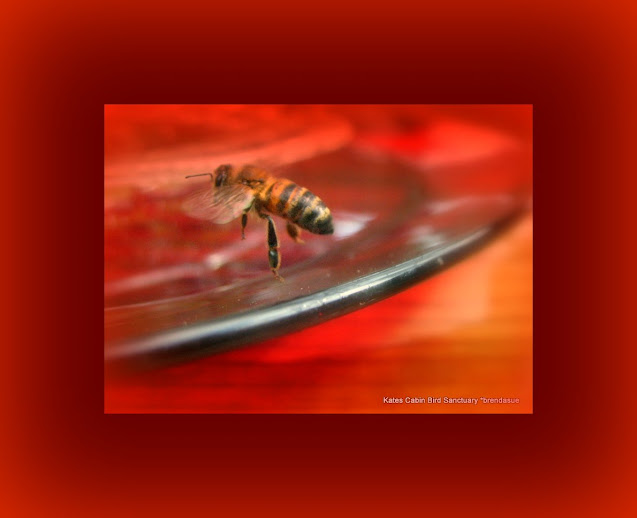
















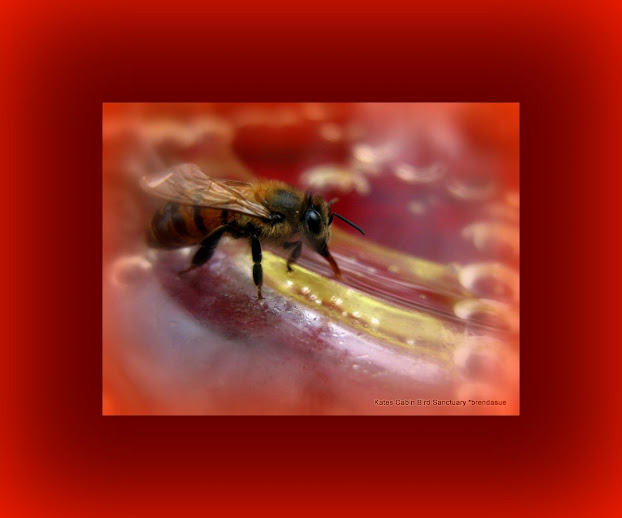





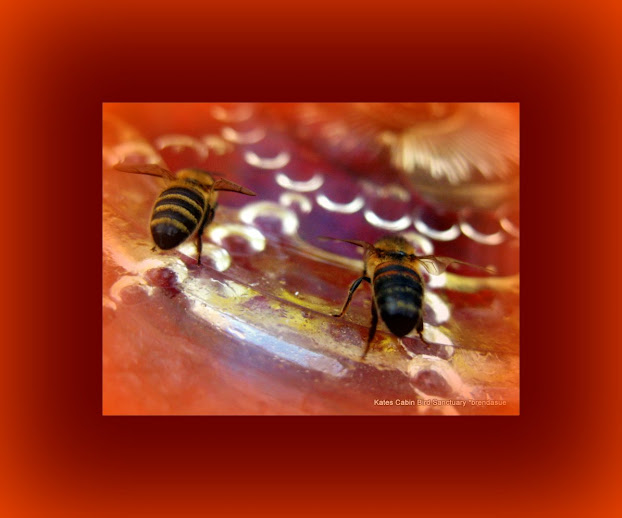


o+o























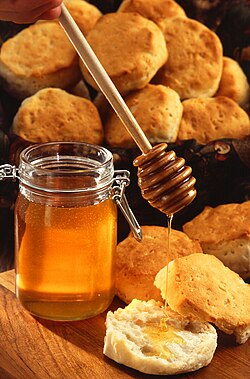







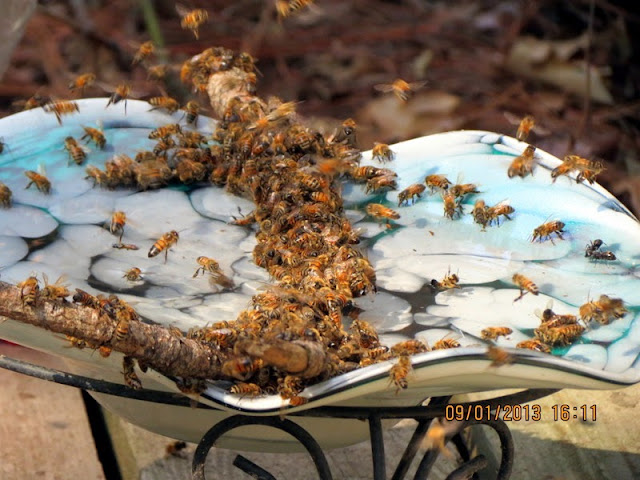













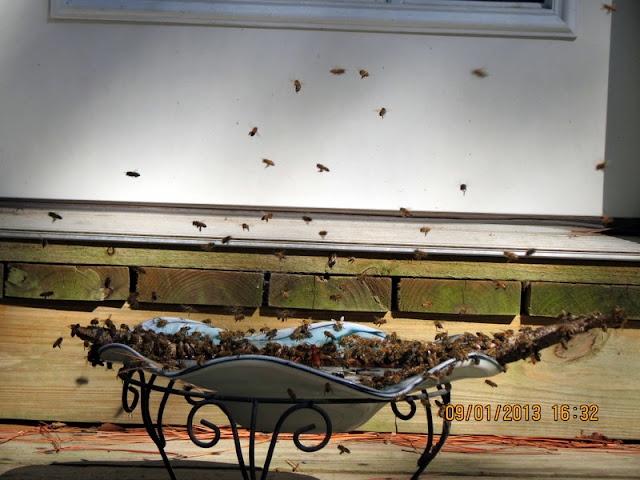




No comments:
Post a Comment
Hi Everybody! Please say hello and follow so I know you are here! Due to the inconsideration of people trying to put commercials on my blog comment area, I have restricted use of anonymous posts. Sorry that some hurt all.
My public email is katescabin@gmail.com No spammers or trolls